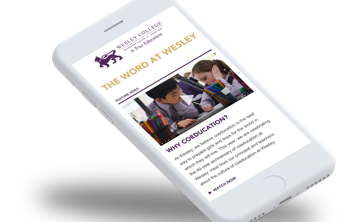
The challenge to teach students remotely became an opportunity for schools to learn other ways to enhance teaching and learning, as Dean Pearman explained to The Age recently.
The abrupt transition to remote learning across Australia quickly dispelled one big myth about schools, digital learning expert Dean Pearman says: that they’re lumbering bureaucracies.
“Across Australia, schools have changed the way they do things, some in as little as five days,” notes Pearman, the Head of Digital Learning and Practice at Wesley College. “We moved 3,500 students and over 600 staff very quickly into a different way of teaching and learning. And we’re all working collaboratively, more so than we have ever in the past.
“That’s been the big take-away for me: just how agile our staff and students are. We’ve proven we can scale up big ideas quickly and have everybody working towards a common goal.”
The overarching principle guiding remote learning at Wesley? Ensuring that students and teachers are given the opportunity to collaborate and connect. “These are the normal things that teaching’s all about: social connections, discussing concepts, providing feedback on learning. It’s about developing learning spaces to enable these connections to occur.”
Pearman’s team initially decided to embrace the tools that were already at the school, such as the Learning Management System Schoolbox. “That sense of normality is important. Schoolbox is our communication platform with parents and students. We have news items and daily updates on what’s happening, and they can receive push notifications from that. Student can access all manner of content relating to their learning via Schoolbox remotely.”
Students in the junior school, meanwhile, have been using the learning platform Seesaw. “We’ve tried to use platforms that students can manage themselves. Seesaw is a key example: it’s designed for primary aged learners, and once they learn it, they should be able to self-manage their learning.”
Teachers have also embraced tools such as Microsoft Stream, which now hosts thousands of hours of videos that have been uploaded to support learning at Wesley.
The school decided not to simply replicate the traditional timetable entirely online. Research suggests that a blended model of live, real-time learning (known as synchronous learning) and pre-recorded, self-paced education (asynchronous learning) is the way to go, Pearman notes
“We looked globally at what works. A key thing is it can’t just be the same as face-to-face learning. We have to give our staff time to prepare, and our students the opportunity to connect and collaborate outside a classroom.” Much of the success of Wesley’s approach was the introduction of Microsoft Teams. “Teams provided a new way for our teachers and students to communicate and connect in real-time with video. The platform meant that our face to face teaching and learning could continue.”
Just as important as the curriculum, Wesley has also focused on ensuring it maintains a sense of community online. The school introduced a wellbeing program called Keep In Touch [KIT], which sees all students meet regularly in small groups with teachers to discuss how everything’s going. Parents are attending regular live Q&A sessions online, and teachers collaborate remotely with the help of Microsoft Teams.
Schools will soon return to ‘normal’, with some of Wesley’s students returning on Tuesday, but Pearman notes the influence this period of remote learning will continue to have. “We developed a whole online professional learning platform for our staff and introduced many new ways to use technologies to enhance teaching and learning. That, and the skills we have all developed throughout this period, will remain.”
And although the Wesley experience of remote learning has been a success, Pearman is also looking forward to seeing all the students back on campus again. “Schools are all about people. Wesley is a hub of energy, and the people within it create that.”
This story by Anders Furze, first appeared in The Age on Sunday 24 May.
